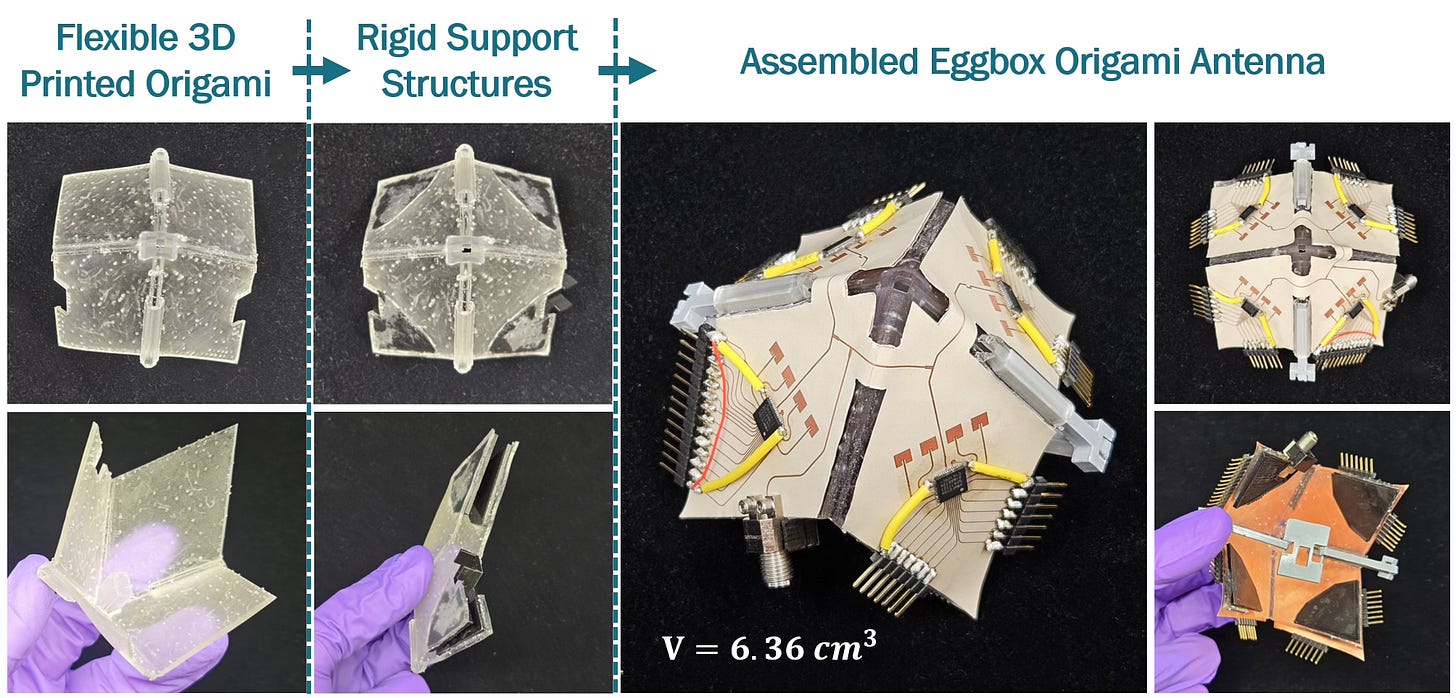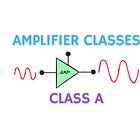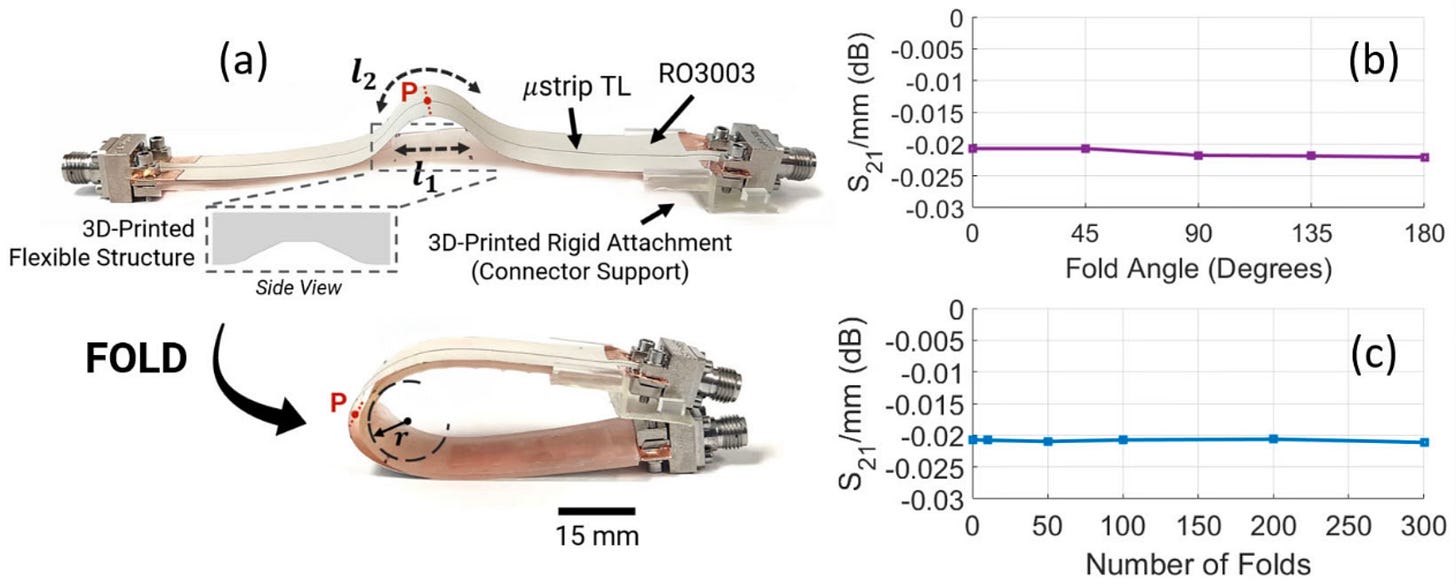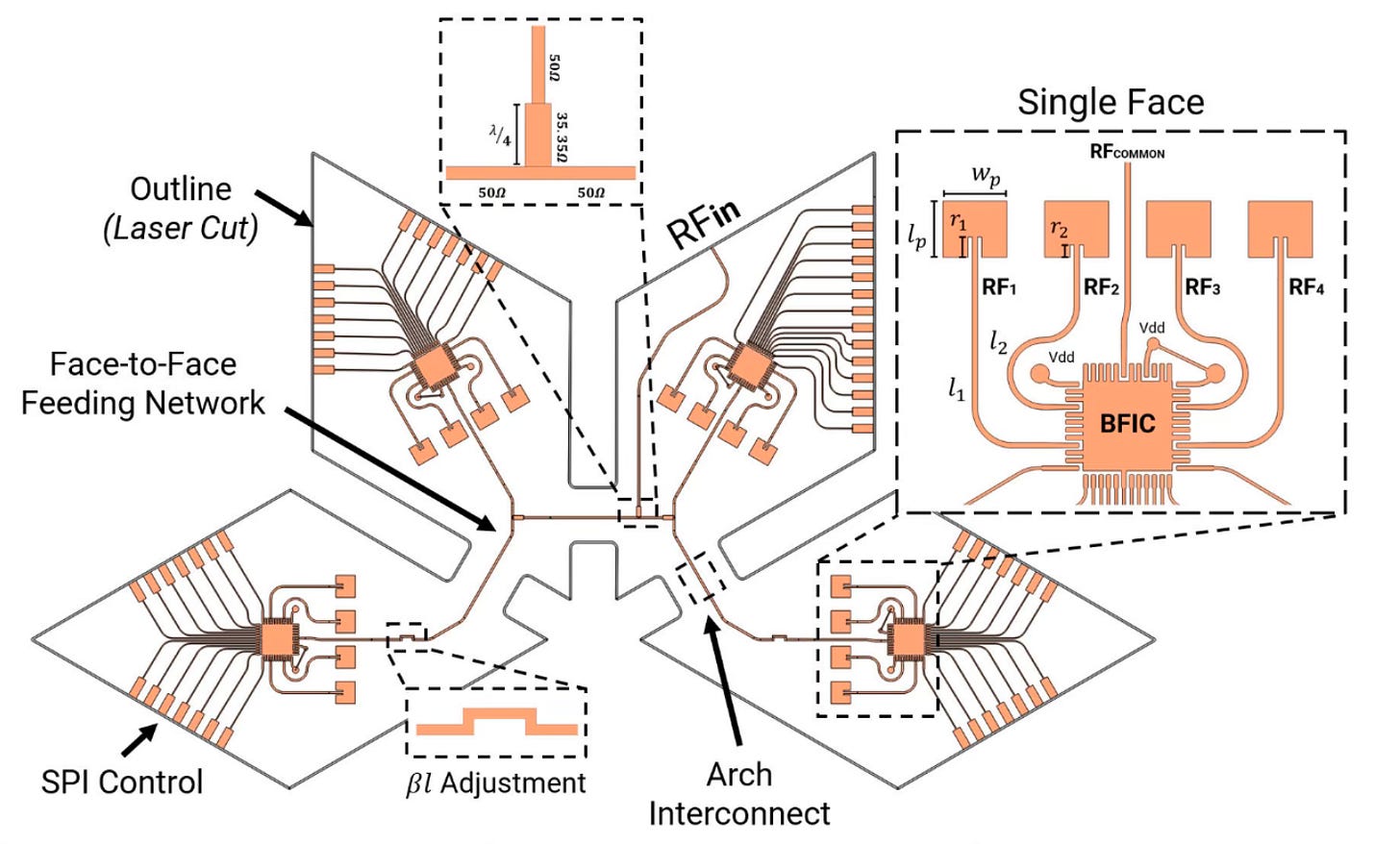How Origami-Inspired Phased Arrays are Reshaping the Future of Antennas
Folding antennas into different shapes to create near infinite radiation patterns.
Hey, I’m Vikram 👋!
It's been a whole month of articles driving hard on RF power amplifier classes. Not sure if you've had enough yet, but my ability to write about power amplifiers is running a bit saturated (all puns intended; I’m sorry 🫠) If you enjoyed the series, or want more articles on power amplifiers, reply to this email and let me know.
If you missed the series, here are the articles you can check out.
This post is too long for email. Please read it on the website.
Cover image origami credit: Rishi Iyer
To freshen things up a bit, I decided to look up latest research from the 2024 International Microwave Symposium, the premier conference in the field of RF and Microwave engineering. What I found was an idea so interesting that I felt compelled to write about it.
As it turns out, there is a new class of RF circuits that draw inspiration from Origami, the Japanese1 art of paper folding. Just like you can make different shapes out of paper, you can physically reconfigure circuits to operate differently.
Hani Al Jamal, a PhD student, and a team of researchers led by Prof. Manos Tentzeris at Georgia Tech, authored a paper titled Beyond Planar: An Additively Manufactured, Origami-Inspired Shape-Changing, and RFIC-Based Phased Array for Near-Limitless Radiation Pattern Reconfigurability in 5G/mm-Wave Applications, which won the Best Paper Award at the 2024 International Microwave Symposium.
This paper describes a phased array antenna from which you can synthesize any radiation pattern. It uses both electronic and physical modifications to achieve this.
Special thanks to Hani for providing additional information, pictures and for reviewing a draft of this post.
In this post, we will get into the details of exactly how this works.
Need for Adaptive RF Circuits
Eggbox Phased Array
Interconnect Systems
Practical Applications
Read time: 9 mins
Need for Adaptive RF Circuits
Fixed RF systems are not optimum for changing RF environments. It is preferable if RF blocks are context aware and adjust to give optimal overall system performance. Previously, reconfigurability meant that components such as antennas were mounted on large servos and moved about to point to the source of the signal. In fact, radio astronomers continue to build big parabolic dishes on train tracks and move them about to make various configurations in order to receive faint signals from space. This is often too slow for modern applications.
Engineers soon realized that they could achieve the same outcomes by steering antennas with phased arrays. Instead of shifting the antennas, they could achieve the same result by adjusting the phase shift between separate antennas. The constructive and destructive interference between the array's antennas helped to steer the radiated beam without physically moving it. Because everything is electronic, steering antennas takes only a few microseconds.
If you need an introduction to antenna and phased arrays, check out my earlier posts.
What if we could combine physical alteration and electronic beam steering? This is an excellent use for foldable phased arrays, as it allows for slow, origami-like physical transformations, followed by quick directional changes via electronic beam steering. Can we create any antenna pattern we desire and then direct the beam?
Eggbox Phased Array
The phased array antenna in the Georgia Tech research paper was inspired by the design of an eggbox made of paper. It's just a grid of upside-down square-base pyramids with an open base for eggs. The research study describes how one of these open-base pyramids might be utilized as a foundation for bigger reconfigurable arrays. When looking at just one of them, the unit cell resembles an origami fortune teller, which my children frequently build.

A 4-element phased array antenna is installed on all four faces of this eggbox-unit/fortune-teller, and the beam is steered in 11.25° increments by a Qorvo AWMF-0108 28 GHz beamformer RFIC.
This unit cell, like an origami design, may be folded across either axis or laid flat, allowing you to physically change the direction of radiation. Because the phased array antenna on each face can steer the beam further, the antenna can be utilized to generate almost any radiation pattern using a combination of physical folding and electronic beam steering.
Here are some ways to shape the radiated beam from this antenna.
360° azimuth coverage: In its pyramidal arrangement, activate only one phased array and direct the beam to its maximum value before switching to the phased array on the next face. This ensures a continuous handoff between multiple phased arrays on the faces while also providing 360° azimuth beam steering.
Bending along an axis: Fold the array along any one axis, and as the fold angle reduces the radiation pattern changes from a four-beam to a two-beam configuration, as illustrated in the image.
Arbitrary shaped beams: Fold the array by an arbitrary angle across either axis, turn on anywhere from a single phased array to all four phased arrays, apply digital weights to the phased array to control both amplitude and phase to antenna elements (even gain tapering to control grating lobes), and you can virtually synthesize any radiation pattern you are looking for.
Interconnect Systems
When you see a foldable circuit running at 28 GHz, the first thing you think about is the foldable interconnect's RF performance and stability over repeated folding. Any fairly skilled RF engineer who has worked in a laboratory understands that RF cables should not be bent. Yet, this is exactly what is required in an origami-based design.
To solve this problem, the authors devised a novel method that employs an arch hinge interconnect that is manufactured utilizing 3D printing technology with flexible80A, a flexible photopolymer resin. The connector is a 50Ω transmission line inkjet printed onto a Rogers RO3003 substrate, paired with 3D printed support structures. The result is a stable hinge design that does maintains low loss over the 180° range of folding, and shows no degradation up to 300 folds.
Another difficulty when constructing interconnects for the eggbox unit cell is that the feed-point can only be located on one of the 3D structure's faces. This means that the interconnect system does not feed the structure's four phased arrays symmetrically2. To compensate for the discrepancy in overall electrical length, extra transmission line sections have been included in the form of a βl adjustment in the figure below.
Practical Applications
The eggbox unit cell can be cascaded to build a bigger array that can be spatially altered along either axis, which is what makes this design so appealing. The modular design method offers other advantages:
If a single unit cell fails, it can readily replaced.
Selective faces of the eggbox array can be activated to generate various radiation patterns based on power usage and transmit/receive operating modes.
The additive 3D printing process generates less waste.
Let's look at some ways this phased array can be effectively used:
Full Duplex Operation: If we would like to use the same antenna array to transmit and receive simultaneously, the modular design allows one to activate all phased arrays on one face for transmitting and use another face for receiving. The capacity to electronically control beams enables them to track targets if necessary.
Multi-beam Operation: By using different folding angles, we already saw how we could synthesize two or four beams from the array. In autonomous cars, for example, each beam can be assigned a particular purpose, such as communication, navigation, or obstacle avoidance.
Adjustable Beam Widths: Because the folding angle determines the width of the beam, unfolding the array to produce vast beam widths aids in aircraft search operations, while folding up the array results in a small beam that aids in focused rescue missions.
Space Constrained Systems: The ability to fold up an antenna array during launch and then deploy while in orbit is particularly useful given the growing popularity of compact form-factor, low-cost spacecraft such as CubeSats. Reshaping the antenna array and directing beams in space will help to construct satellite mesh networks, increasing connectivity around the world.
This implementation of an origami-inspired antenna has only two degrees of freedom, but it establishes the way for future developments that will include even more degrees of freedom for reconfigurability.
The capacity to freely adjust radiation beams will be critical to the future of wireless communications, whether for 5G, 6G, automotive radar, space, or military applications.
If you love these paper review articles, please respond to this email and let me know so that I can write more. If you come across any intriguing articles that feature a brilliant idea or a novel implementation, send them my way and I'll address them in a future newsletter post.
References
[1] H. A. Jamal, C. Hu, N. Wille, K. Zeng and M. M. Tentzeris, "Beyond Planar: An Additively Manufactured, Origami-Inspired Shape-Changing, and RFIC-Based Phased Array for Near-Limitless Radiation Pattern Reconfigurability in 5G/mm-Wave Applications," in IEEE Microwave and Wireless Technology Letters, vol. 34, no. 6, pp. 841-844, June 2024, doi: 10.1109/LMWT.2024.3396026.
About the Author
Hani Al Jamal received the B.E. degree in Electrical and Computer Engineering from the American University of Beirut (high distinction) and a minor in Applied Mathematics in 2022. He is currently pursuing the Ph.D. degree in Electrical and Computer Engineering with the Georgia Institute of Technology, where he is involved in utilizing additive manufacturing techniques to design highly integrated, conformal, and morphing RF front-end circuits, antennas, and packaging up to mm-wave frequencies.
Al Jamal aspires to design and build communication devices and RF electronics that draw inspiration from origami and art, leading to enhanced functionality and physical flexibility to seamlessly integrate with human-centered devices, thereby enabling more efficient and integrated communication networks for digital awareness.
If you like this post, please click ❤️ on Substack, subscribe to the publication, and tell someone if you like it. 🙏🏽
If you enjoyed this issue, reply to the email and let me know your thoughts, or leave a comment on this post.
We have a community of RF professionals, enthusiasts and students in our Discord server where we chat all things RF. Join us!
The views, thoughts, and opinions expressed in this newsletter are solely mine; they do not reflect the views or positions of my employer or any entities I am affiliated with. The content provided is for informational purposes only and does not constitute professional or investment advice.
All images in this post have been used with express permission of the author.
It really got popular in Japan, but its origins are unclear.
This is important for proper beamforming. You want phase shifts to be controlled only by the beamformer IC and not have static shifts from things like interconnect systems.













